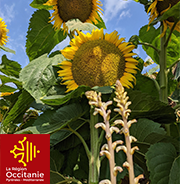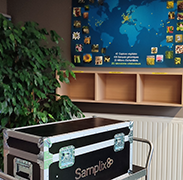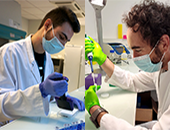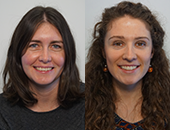Newsletter 2022
Occitanie-GENOSOL project |
|
|
| Occitanie-GENOSOL is a project funded by the " région Occitanie" in the framework of its fund to sustain regional research and innovation platforms. The CNRGV is the project leader in partnership with the LIPME (UMR INRAE CNRS) and the company Innolea. Genosol aims to identify the molecular basis of resistance of sunflower to major pests, including Orobanche cumana. This knowledge will be used to select more resistant sunflower varieties. The project is funded for 18 months. |
|
Genome optical service | ||
|
| New version of the Bionano optical maps systemThe CNRGV has installed the latest version of the Saphyr in August 2021 thanks to funding from the "région Occitanie", as part of the Occitanie-GENOSOL project. This new version of the optical map production device designed by the company Bionano offers improved throughput and performance. Coupled with sequence data, the new optical maps produced will make possible to obtain genome assemblies at the chromosome level. |
|
|
| Bionano certified the CNRGV as service provider for optical genome mapsBionano has awarded the certification of "service provider" to the CNRGV. Based on both a theoretical and practical review of our processes, this certification recognizes the expertise of the CNRGV for the production and analysis of plant genome optical maps. |
|
From seed to genome | ||
| The CNRGV relies on its expertise in plant genomics developed since 2004 to propose a complete service "from seed to genome". This service includes all the steps from the production of plant material, from seeds, to the assembly of sequence data. The objective is to deliver a high quality genome sequence. In 2021 this amounted: |
||
|
| 46 optical mapsThe CNRGV has produced almost 250 optical genome maps since 2016, including 46 in 2021. Optical maps allow to study the structural variations inter- or intraspecie. Unique in its principle, it is an unvaluable tool for the improvement of genome assembly. |
|
|
| 30 plant genomes sequenced and assembledWe extract high molecular weight DNA and prepare it for long reads sequencing. Sequencing is performed using PacBio sequencing services from several platforms including those of the INRAE Genomics infrastructure. PacBio's Sequel II sequencer is currently used to obtain long Hifi reads of 15 to 20 Kb with 99.9% accuracy, which allow for high quality assemblies.49 genomes have been produced as of 2019. |
|
|
| 33 genome sequence improvements through hybrid assembly.The combination of optical map data with PacBio Hifi reads, regularly allow us to obtain chromosome-scale assemblies of complex plant genomes. |
|
New method development |
||
|
| SamplixIn the fall of 2021 we acquired a new technology designed to capture large targeted DNA fragments developed by Samplix. This technology relies on the selective labelling of DNA fragments isolated in droplets by Samplix Xdrop device. The droplets containing the labelled DNA molecules are sorted by flow cytometry then sequenced using a long-reads technology. |
|
|
| Pull CATCHWe have developped a targeted approach to sequence capture called Pull CATCH. It allows to capture a large sequence of interest, up to 200kb, within multiple genotypes in parallel. The Pull CATCH method is implemented in the framework of collaborations. |
|
Publications | ||
|
| New publications in 2021A Genome Sequence Resource for the Genus Passiflora, the Genome of the Wild Diploid Species Passiflora Organensis . The Plant Genome, 2021 Nov;14(3):e20117. doi: 10.1002/tpg2.20117. Population genomics of apricots unravels domestication history and adaptive events. Nature Communications 1–16. doi: 10.1038/s41467-021-24283-6. A Common Bean Truncated CRINKLY4 Kinase Controls Gene-for-Gene Resistance to the Fungus Colletotrichum Lindemuthianum. Journal of Experimental Botany 72(10):3569–81. doi: 10.1093/jxb/erab082. Building a Cluster of NLR Genes Conferring Resistance to Pests and Pathogens: The Story of the Vat Gene Cluster in Cucurbits. Horticulture Research 8(1). doi: 10.1038/s41438-021-00507-0. Alleles of a Wall-Associated Kinase Gene Account for Three of the Major Northern Corn Leaf Blight Resistance Loci in Maize. Plant Journal 106(2):526–35. doi: 10.1111/tpj.15183. A Wheat Cysteine-Rich Receptor-like Kinase Confers Broad-Spectrum Resistance against Septoria Tritici Blotch. Nature Communications 12(1):1–10. doi: 10.1038/s41467-020-20685-0. |
|
Staff | ||
|
| RecruitmentsRobin Schwartz joins the team as a technician on a one-year contract. Anthony Theron is recruited on a engineer permanent position. |
|
|
| End of contractsSandrine Arribat and Carine Satge completed their engineer fixed-term contract |
|
|
| RetirementJoelle Fourment - Assistant Engineer - We warmly greet Joëlle for her investment throughout her 41-year career at INRA and then at INRAE, including 17 years at CNRGV. |
|
Direction | ||
|
| Arnaud Bellec is appointed director of the CNRGV from January 2022. He succeeds Sonia Vautrin, former director since 2019 in the frame of a collegiate management. |
|













